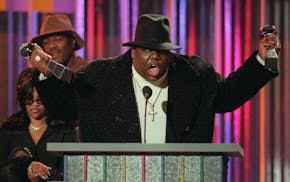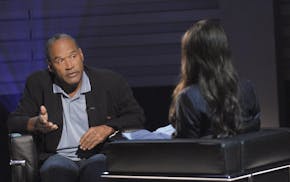This year's Momentum Series at the Southern Theater (presented by the Cowles Center in partnership with the Southern and the Walker) launches with a bleak pair of dance works that mine dark themes of humanity. Between the dystopian future prescribed by the dance duo Hiponymous (Renée Copeland and Genevieve Muench) and the disjointed community created by the dancers in Luke Olson-Elm's piece, the evening paints a somber tone throughout.
With fears of environmental disaster, economic collapse, war and turmoil dominating the news cycle, not to mention the lucrative success of "The Hunger Games," it's no wonder dystopia is pervasive in popular culture. With "State of the Moon Address," Hiponymous hits on the zeitgeist while also nodding to such predecessors as George Orwell and Margaret Atwood.
Sam Pitmon and Jason Quick's set plays a key role in the work. Taking up much of the stage is a giant mound, covered in plastic grass. Copeland makes her entrance by clawing her way out of the mound, and later the dancers attempt to dig into it using oversized gardening tools, but find that the only things that will grow from it are scary antennas.
Omnipresent is the sound of the only news channel in this world, which warns the citizens of dangerous robbers and announces an executive order banning forgiveness. There are also commercials that sometimes overtake the two performers as they don forced smiles. The Weathermen (Karen Keir and Tom Woodling), meanwhile, create a futuristic soundscape.
The specificity of the oppressive regime in "State of the Moon Address," made clear by the voiceover text, roots the work firmly as a genre piece. Olson-Elm avoids that in "Broken," which is more abstract and less easy to pin down as science fiction.
"Broken" is framed by a set-up of light spots. The dancers move in and out of the light with strong, athletic force. The piece and the dancers are driven by Olson-Elm's relentless industrial sound score. At times, it's almost as if they are workers in a factory, desperately trying to break out of their forced circumstances.
Different dancers do break away, but Sarah Steichen emerges as the predominant figure, reaching her arms up into the light as if striving for freedom. Steichen captivates with her intense physical prowess and her facial expression. It is her character that eventually reaches out to touch another dancer, an electric moment revealing the need for human connection.
Sheila Regan is a Minneapolis writer.

ABBA, Blondie, and the Notorious B.I.G. enter the National Recording Registry
West Virginia transgender sports ban discriminates against teen athlete, appeals court says
Dr. Martens shares plunge to record low after weak US revenue outlook
Visa fees for international artists to tour in the US shot up 250% in April. It could be devastating

